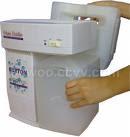
water distillers
Environmental concerns are part of our society’s daily consciousness. While most of us can’t tangibly recognize melting glaciers, rising sea levels, or holes in our atmosphere, we may be directly affected every time we run the tap. As early as ten years ago we as a society believed that local governments took the health and safety of its citizens seriously, but rarely did they give a second thought to what may be lurking in our water supplies. Now, ever-growing concerns about the presence of contaminates in our drinking water has spurred action.
The Natural Resources Defense Council's study of water systems for 19 U.S. cities found that pollution and deteriorating, out-of-date plumbing sometimes delivers unsafe drinking water.
"Many cities around the country rely on pre-World War I-era water delivery systems and treatment technology. Aging pipes can break, leach contaminants into the water they carry and breed bacteria.”
Contaminates repeatedly found in the cities surveyed were lead, pathogens (germs), by-products of chlorine treatment, arsenic, and radon; a few ways these contaminates reach drinking water are from sewer system overflows after heavy rains, runoff from roads, agricultural and domestic fertilizers, and industrial pollutions leached into ground water.
Most people have switched to drinking bottled water, only to discover that our landfills are beyond capacity, thanks largely to the plastic bottles compounding the problem of pollution. The trend these days is the use of tap mounted and pitcher filtration devices. But the distillation process is becoming increasingly popular due to its efficiency.
How It Works
This method works just like the water cycle taught in elementary earth science. The water is heated to its boiling point until it creates steam by evaporation. The stable temperature keeps the water vaporization in process, meanwhile prohibiting contaminants and sediments from being evaporated. The evaporated water is captured and sent through to another container where it cools and condenses back into its liquid form.
Water distillers is effective in removing inorganic compounds, such as metals (iron and lead), hardness (calcium and magnesium), and other harmful contaminates from the water supply. Microorganisms such as bacteria and some viruses are discarded through the boiling process, which also helps to rid the water of some organic compounds and pesticides
.
source: articlesbase.com
water distillers
Environmental concerns are part of our society’s daily consciousness. While most of us can’t tangibly recognize melting glaciers, rising sea levels, or holes in our atmosphere, we may be directly affected every time we run the tap. As early as ten years ago we as a society believed that local governments took the health and safety of its citizens seriously, but rarely did they give a second thought to what may be lurking in our water supplies. Now, ever-growing concerns about the presence of contaminates in our drinking water has spurred action.
The Natural Resources Defense Council's study of water systems for 19 U.S. cities found that pollution and deteriorating, out-of-date plumbing sometimes delivers unsafe drinking water.
"Many cities around the country rely on pre-World War I-era water delivery systems and treatment technology. Aging pipes can break, leach contaminants into the water they carry and breed bacteria.”
Contaminates repeatedly found in the cities surveyed were lead, pathogens (germs), by-products of chlorine treatment, arsenic, and radon; a few ways these contaminates reach drinking water are from sewer system overflows after heavy rains, runoff from roads, agricultural and domestic fertilizers, and industrial pollutions leached into ground water.
Most people have switched to drinking bottled water, only to discover that our landfills are beyond capacity, thanks largely to the plastic bottles compounding the problem of pollution. The trend these days is the use of tap mounted and pitcher filtration devices. But the distillation process is becoming increasingly popular due to its efficiency.
How It Works
This method works just like the water cycle taught in elementary earth science. The water is heated to its boiling point until it creates steam by evaporation. The stable temperature keeps the water vaporization in process, meanwhile prohibiting contaminants and sediments from being evaporated. The evaporated water is captured and sent through to another container where it cools and condenses back into its liquid form.
Water distillers is effective in removing inorganic compounds, such as metals (iron and lead), hardness (calcium and magnesium), and other harmful contaminates from the water supply. Microorganisms such as bacteria and some viruses are discarded through the boiling process, which also helps to rid the water of some organic compounds and pesticides
.
source: articlesbase.com
water distillers

